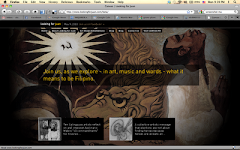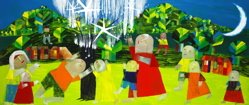 Genaro Gojo Cruz (left) and Anthony Palomo (right) flank "Ama at Anak: Simbang Gabi" - the cover piece for CANVAS' latest children's book.
Genaro Gojo Cruz (left) and Anthony Palomo (right) flank "Ama at Anak: Simbang Gabi" - the cover piece for CANVAS' latest children's book.In rural Barangay Pastol, Mang Tomas drives an aging, red jeepney – the very first in town. Everyone knows his jeep because it is witness to everything – each child’s baptism, each couple’s walk down the aisle, each student’s graduation from school. Neighbors seeking work abroad are seen to the airport by Mang Tomas’ jeepney and, just the same, it is the jeepney that welcomes them back home.
These are scenes from CANVAS’ newest children’s book, Ang Dyip ni Mang Tomas, story by Genaro Gojo Cruz and artworks by Anthony Palomo.
For Cruz, the author, the story had been with him for a long time. “My father drove an old, red jeep all his life,” he shares. In fact, Mang Tomas is Cruz’s father and the child is Genaro himself. The Romeo Forbes Children’s Story Writing Competition, held annually by CANVAS, became the perfect opportunity for Cruz to finally put his story down on paper. “When I began writing it, it came easy because it was already finished in my mind.”
For artist Anthony Palomo, however, it did not come as easily at first. “Starting is always the most difficult,” he says. “One painting is a story, you see,” Palomo explains, “and everything in Ang Dyip … was just one painting cut into pieces.” He struggled to match images to Mang Tomas’ story but finally began. “Ama at Anak: Simbang Gabi,” (shown above) was actually the first artwork to be completed. It pictured a father cradling his newborn against a backdrop of the family jeep and a church lit for Simbang Gabi. Perhaps it was just as well because the painting captured the story’s very essence – the love between father and child.
“Through his jeep, Tatay provided for us,” Cruz, the youngest of nine children recalls. “He also showed us how hard-working he was, a trait that my siblings and I inherited. We learned that one must work hard to achieve in life.” In the province, owning a jeep is often a measure of one’s progress or success.
“The old jeep I talk about in the story is gone,” says Cruz, “but all my brothers drive their own jeepneys and provide for their families in this way. I am the only one who doesn’t because I dreamed of finishing my studies and becoming a writer and teacher.”
Though Palomo and Cruz never met until the very night of the book launch and exhibit opening, the images and story are a stunning fit. Together, the author’s words and the artist’s brushstrokes compellingly tell the story of Mang Tomas, his trusty jeep, and a young son’s tribute to his father.
Ang Dyip ni Mang Tomas is CANVAS’ ninth children's book and is available at 1/of Gallery in Serendra at The Fort, at the Ayala Museum, and can soon be purchased at various Fully Booked and Powerbooks branches.
The book launch and show were held at ArtistSpace, Ayala Museum on October 15 through October 27, 2009.








